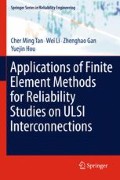Abstract
The complexity of the physics of electromigration and the stress-induced voiding can be seen in Chap. 2. In order to model the physics realistically in today’s interconnects so as to obtain better understanding of the physics and to identify key parameters, FEM is needed as pointed out in Chap. 2. To begin the discussion on FEM applications in electromigration and stress-induced voiding, let us have a basic understanding on the FEM. For readers familiar with FEM, this chapter may be skipped.
Access this chapter
Tax calculation will be finalised at checkout
Purchases are for personal use only
References
Courant R (1943) Variational methods for the solution of problems in equilibrium and vibrations. Bull Am Math Soc 49:1–23
Turner MJ, Clough RW, Martin HC, Topp LJ (1956) Stiffness and deflection analysis of complex structures. J Aeronaut Sci 23:805–824
Noor AK (1991) Bibliography of books and monographs on finite element technology. Appl Mech Rev 44:307–317
Moes N, Cloirec M, Cartraud P, Remacle J-F (2003) A computational approach to handle complex microstructure geometries. Comput Methods Appl Mech Eng 192:3163–3177
Weide-Zaage K, Dalleaua D, Yu X (2003) Static and dynamic analysis of failure locations and void formation in interconnects due to various migration mechanisms. Mater Sci Semicond Process 6:85–92
Shen Y-L, Guo YL, Minor CA (2000) Voiding induced stress redistribution and its reliability implications in metal interconnects. Acta Mater 48:1667–1678
Nguyen HV, Salm C, Wenzel R, Mouthaan AJ, Kuper FG (2002) Simulation and experimental characterization of reservoir and via layout effects on electromigration lifetime. Microelectron Reliab 42:1421–1425
Zhang YW, Bower AF, Xia L, Shih CF (1999) Three dimensional finite element analysis of the evolution of voids and thin films by strain and electromigration induced surface diffusion. J Mech Phys Solids 47:173–199
Kuroda S, Kawai Y, Onoda H, Nishi K (1991) Viscoelasticity-based time-dependent stress model for a submicron aluminum interconnect. IEDM, pp 713–716
Wallace B, Lee Y-H, Pantuso D, Wu K, Mielke N (1999) Thermo-mechanical stress-induced voiding in a tungsten-AlCu interconnect system. In: 37th annual international reliability physics symposium, pp 303–309
Im S, Banejee K, Goodson KE (2002) Modeling and analysis of via hot spots and implications for ULSI interconnect reliability. In: 40th annual international reliability physics symposium, pp 336–345
Huang TC, Yao CH, Wan WK, Hsia CC, Liang MS (2003) Numerical modeling and characterization of the stress migration behavior upon various 90 nanometer Cu/low-k interconnects. In: Proceedings of the IEEE international interconnect technology conference, pp 207–209
Chen F, Chanda K, Gill I, Angyal M, Demarest J, Sullivan T, Kontra R, Shinosky M, Li J, Economikos L, Hoinkis M, Lane S, McHerron D, Inohara M, Boettcher S, Dunn D, Fukasawa M, Zhang BC, Ida K, Ema T, Lembach G, Kumar K, Lin Y, Maynard H, Urata K, Bolom T, Inoue K, Smith J, Ishikawa Y, Naujok M, Ong P, Sakamoto A, Hunt D, Aitken J (2005) Investigation of CVD SiCOH low-k time-dependent dielectric breakdown at 65 nm node technology. In: Proceedings of the international reliability physics symposium, pp 501–507
Tsu R, McPherson JW, McKee WR (2000) Leakage and breakdown reliability issues associated with low-k dielectrics in a dual-damascene Cu process. In: IEEE 38th annual international reliability physics symposium, San Jose, California, pp 348–353
Zienkiewicz OC (1977) The finite element method, 3rd edn. McGraw-Hill, New York
Becker EB, Carey GF, Oden JT (1981) Finite elements: an introduction, vol I. Prentice-Hall, Englewood Cliffs
Moaveni S (1999) Finite element analysis: theory and application with ANSYS. Prentice Hall, Englewood Cliffs
Swanson Analysis System, Inc (1999) ANSYS theory reference, 5.6 edn. Swanson Analysis System, Inc., Houston
White FM (1988) Heat and mass transfer. Addison-Wesley, New York
Rohsenow WM, Hartnett JP, Ganic EJ (1985) Handbook of heat transfer fundamentals. McGraw-Hill, New York
Timoshenko SP, Goodier JN (1970), Theory of elasticity, 3rd edn. McGraw-Hill, New York
Dieter GE (1988) Mechanical metallurgy. McGraw-Hill, London
ANSYS, Inc (2009) ANSYS parametric design language guide, 12th edn. ANSYS, Inc., Canonsburg
Author information
Authors and Affiliations
Corresponding author
Rights and permissions
Copyright information
© 2011 Springer-Verlag London Limited
About this chapter
Cite this chapter
Tan, C.M., Gan, Z., Li, W., Hou, Y. (2011). Introduction and General Theory of Finite Element Method. In: Applications of Finite Element Methods for Reliability Studies on ULSI Interconnections. Springer Series in Reliability Engineering. Springer, London. https://doi.org/10.1007/978-0-85729-310-7_3
Download citation
DOI: https://doi.org/10.1007/978-0-85729-310-7_3
Published:
Publisher Name: Springer, London
Print ISBN: 978-0-85729-309-1
Online ISBN: 978-0-85729-310-7
eBook Packages: EngineeringEngineering (R0)

